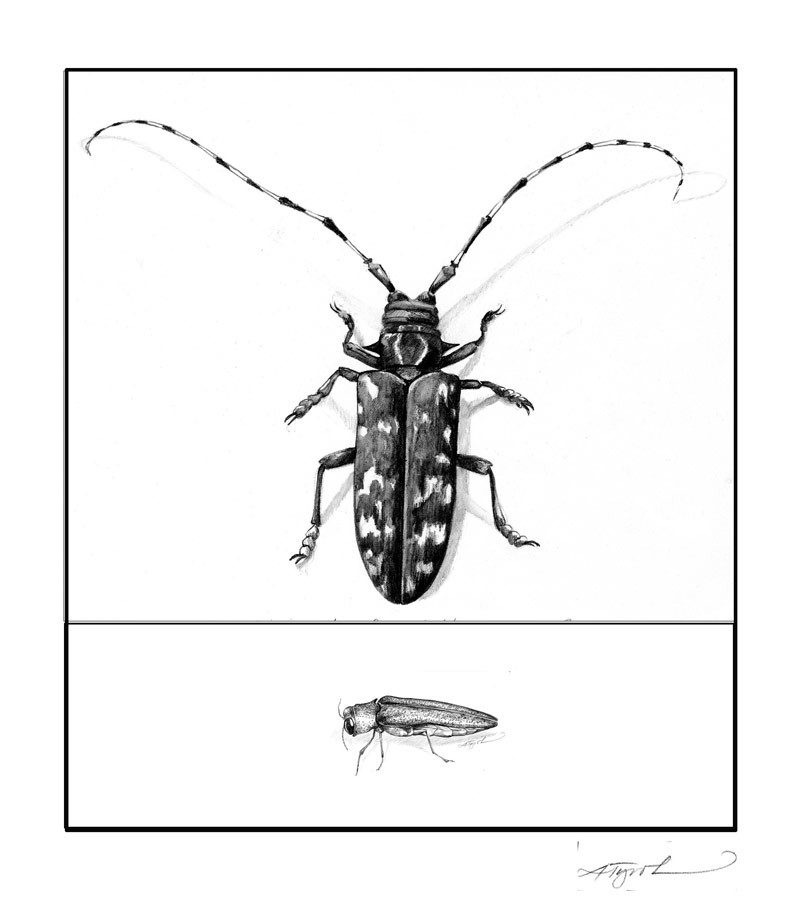
Amanda Priestley is on the hunt for a tree killer, and she wants your help.
Priestley is an outreach specialist with the Vermont Agency of Agriculture. On a muggy morning in July, she leads a dozen volunteers to a spindly sugar maple near the municipal library in South Burlington, Vt. This is one hurting maple tree: its crown is thinning, and dead branches show through yellowing leaves.
The tree is not infested with any exotic insects, but Priestley is using it to demonstrate how a maple might appear after being attacked by the Asian longhorned beetle, one of two insect pests munching their way toward Vermont and New Hampshire. Priestley points to splits in the bark high on the tree trunk. “From there, you would look for exit holes; you would look for sawdust at the base,” she tells the volunteers.
The workshop is part of a multi-pronged, regional effort to detect and contain the Asian longhorned beetle and the emerald ash borer. As alien invaders without natural enemies in New England, these two insects have the potential to devastate the Northern Forest.
The longhorned beetle is about an inch and a half long, with a jet-black body punctuated with irregular white spots. Its antennae are also black and white, and are longer than its body. Native to China, the Asian longhorned beetle probably found it way to the United States in wooden shipping pallets. The beetle was found in Brooklyn, N.Y., in 1996, and spotted in Chicago two years later. And last year a huge infestation was discovered in Worcester, Mass., just 60 miles south of Vermont and New Hampshire. The beetle feeds on as many as a dozen different hardwoods, but it has a special affinity for maple trees.
Imagine autumn without color from maple trees, Priestley says. Or, how about spring without the traditional flow of maple sap?
The emerald ash borer, as the name suggests, has a shiny green body and feeds on ash trees. Originally discovered in Detroit and nearby Windsor, Ontario, in 2002, and probably also carried in shipping pallets, it has rapidly spread east killing untold millions of ash trees. The borer is moving closer to New England; it was recently discovered near Buffalo, N.Y., and Montreal.
Both Vermont and New Hampshire are responding—using public education, strengthened regulation, and new investigative techniques in efforts to halt the spread of the insects. For example, scientists have baited hundreds of traps with pheromones – chemical signals that insects use to lure a mate – to look for the emerald ash borer. In Vermont they have enlisted the aid of an insect-eating wasp (Cerceris fumipennis) in their hunt for the bug. The female wasp provisions her nest with a variety of metallic looking, wood-chomping beetles to feed her young. If there are any emerald ash borers in the area, the wasps might carry them to their nests. By monitoring the nests, entomologists hope to detect any outbreak in its early stages.
But the main focus remains on educating humans who might inadvertently carry either of the pests into the region.
Neither bug flies very well. But they’ve spread rapidly because they stow away in firewood that people move to campgrounds and vacation homes. “They can live in dead wood, so they’ll emerge and potentially spread to other locations,” says Steven Sinclair, Vermont’s state forester. “So moving firewood is a hidden danger … the general public may not even know what they’re doing.”
Forestry officials in both states have banned out-of-state firewood from their state and federal campgrounds. Visitors face a $5,000 fine if they’re caught transporting untreated wood from outside the region into the Green Mountain and White Mountain National Forests.
The first outbreaks of the Asian longhorned beetle were in urban environments where diseased trees were more easily seen. Researchers believe the beetles were in Worcester, Mass., about 10 years and began spreading to nearby woods. In New Hampshire officials are checking the state’s records to learn who from the Worcester area may have visited any of the state campgrounds, explains Brad Simpkins, acting state forester and director of the forest and lands division.
“There’s a very good likelihood that wood from that quarantine area has come into New Hampshire, Maine, Vermont and the other New England states,” he says. Officials are now searching the state park visitor database for anyone with a Worcester-area zip code. “We’re trying to determine the most likely places that this wood may have come to in the past decade, and then (we’re) trying to check those areas,” Simpkins says. “If there is a satellite infestation, we would just hit it really early, and hit it hard if we can.”
Scientists have had some success in treating suburban trees with insecticides to kill both types of insects, but large-scale pesticide application may be unrealistic in many forest settings. Unfortunately, felling the tree and destroying the wood remains the most effective way to kill these two insects.


Discussion *